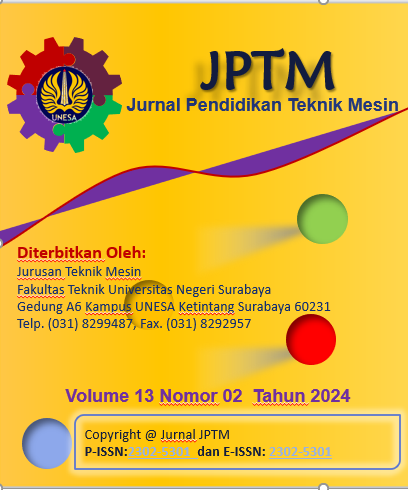Array
Pengembangan modul ajar ABS
DOI:
https://doi.org/10.26740/jptm.v13n02.p190-195Keywords:
pengembangan, media pembelajaran, respon, SMK, modul, anti lock-braking systemAbstract
This research aims to develop learning media in the form of an Anti Lock-Braking System Trainer teaching module for the TBSM subject. From the results of observations at Kartanegara Vocational School, Kediri, it shows that the Anti Lock-Braking System teaching module is not yet available. For this reason, researchers will develop an Anti Lock-Braking System teaching module that can be used in learning about motorbike chassis maintenance subjects. This research uses the R&D method with the EDDIE model, has 5 stages, namely analysis, design, development, implementation and evaluation. The data collection technique uses a 4-scale questionnaire instrument to validate teaching modules and student responses. The data analysis used is descriptive percentage. This data is to determine the level of feasibility of the teaching module. The results show that the ABS teaching module is suitable for use with an average validation score for material of 87.5%, media of 78%, and language of 89.5%. And the student response was 86.42%. Based on the research results, the ABS teaching module developed was proven to be feasible.
Keywords: Development, learning media, response, vocational school, module, anti-lock-braking system
Downloads
References
1. Dick, W., & Carey, L. (2009). The systematic design of instruction. Belmont, CA: Wadsworth Publishing Company
2. Morrison, G. R., Ross, S. M., & Kemp, J. E. (2007). Designing effective instruction. New Jersey: Pearson Education.
3. Nurkholis. (2013). Pendidikan dalam upaya memajukan teknologi. Jurnal Kependidikan, 1(1), 24-44.
4. Sadiman, A. S. (2012). Media pendidikan: Pengertian, pengembangan, dan pemanfaatannya. Jakarta: PT Raja Grafindo Persada.
5. Sugiyono. (2010). Metode penelitian pendidikan pendekatan kuantitatif, kualitatif, dan R&D. Bandung: Alfabeta.
6. Sugiyono, A. (2013). Metode Penelitian Kuantitatif, Kualitatif, dan R&D. Bandung: Alfabeta.
7. Thorndike, E. L. (1905). The elimination of colonies in ants. Journal of Animal Behavior, 1(1), 3-47.
8. Thorndike, E. L. (1913). The psychology of learning. New York: The Century Co.
9. Thorndike, E. L. (1918). Mental life of animals. In C. J. Herrick (Ed.), The foundations of science (pp. 221-261). New York: The Macmillan Company.
10. Tjiptiany, E. N., Yuliana, S., & Khoiriyah, N. D. (2016). Pengembangan modul pembelajaran matematika dengan pendekatan inkuiri untuk membantu siswa SMA kelas X dalam memahami materi peluang. Jurnal Pendidikan Teknologi dan Kejuruan, 19(2), 112-121.
11. Wulandari, Z., & Taufik, E. (2017). Kajian kualitas produk susu pasteurisasi hasil penerapan rantai pendingin. Jurnal Ilmu Produksi dan Teknologi Hasil Peternakan, 5(3), 94-100.
12. Fraenkel, J. R & Wallen, N. E. (2009). How to Design and Evaluate Research in Education 7th ed. Boston: McGraw-Hill
Published
Issue
Section
 Abstract views: 41
Abstract views: 41





